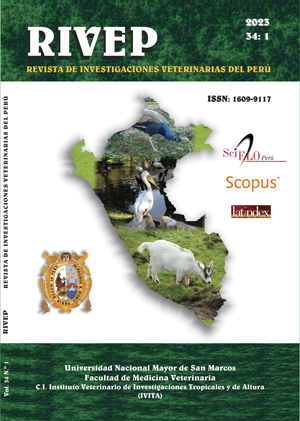Protein synthesis by fermentation of sugar cane added with urea and lactic acid culture
DOI:
https://doi.org/10.15381/rivep.v34i1.22993Keywords:
biotecnology, food crops, microbiology, nutrition, ruminant, tropicAbstract
The aim of this study was to evaluate the crude protein (CP) and true protein (TP) content of sugarcane after the solid-state fermentation process (SSF) with and without addition of urea or an inoculum of Pediococcus acidilactici, Lindner. Nine aerobic silos were used where three treatments were evaluated: ground whole cane (GWC), GWC plus 2% urea (GWCu) and GWC inoculated with 108 CFU of P. acidilactici (GWClab). pH, CP and TP levels were measured, as well as changes in the microbial populations. The pH was higher than 6.1, except for GWCu where it was lower (5.6; p<0.05). The amounts of CP and TP were low, without differences between treatments until the end of the incubation period (72 h). Low amounts of lactic acid bacteria (lab) were observed in GWCu, with no significant differences in GWC and GWClab (p>0.05). In the periods of 48 and 72 h, the number of cellulolytic and total bacteria were similar (p>0.05) between treatments. The FES of sugarcane allows to conserve forage, but in the short term it does not improve the content of CP and TP in the dry matter (DM), even with the addition of probiotics or urea.
Downloads
Downloads
Published
Issue
Section
License
Copyright (c) 2023 Alejandro Ley-de Coss, José R. Bárcena-Gama, Candido E. Guerra-Medina, Oziel D. Montañez-Valdez, Salvador Pérez-López, Eugenia Barrientos-Niño, Reynerio Adrián Alonso Bran, José C. Escobar-España

This work is licensed under a Creative Commons Attribution 4.0 International License.
AUTHORS RETAIN THEIR RIGHTS:
a. Authors retain their trade mark rights and patent, and also on any process or procedure described in the article.
b. Authors retain their right to share, copy, distribute, perform and publicly communicate their article (eg, to place their article in an institutional repository or publish it in a book), with an acknowledgment of its initial publication in the Revista de Investigaciones Veterinarias del Perú (RIVEP).
c. Authors retain theirs right to make a subsequent publication of their work, to use the article or any part thereof (eg a compilation of his papers, lecture notes, thesis, or a book), always indicating the source of publication (the originator of the work, journal, volume, number and date).










